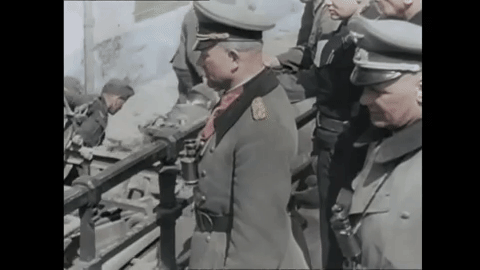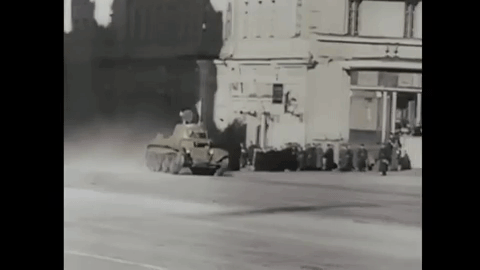Blitzkrieg!
So, this series takes a microscope to World War II and focuses just on one particular aspect of the war. This page looks at panzers during the early Blitzkrieg days of World War II. So, click on the videos below if you would like to see some good footage of German tanks blowing stuff up!
 |
| General Heinz Guderian at the Meuse crossing in 1940. |
Heinz Wilhelm Guderian was a German general who literally wrote the book on armored tactics during the 1930s. Many consider him the top authority on tank tactics. "Panzer Leader" is a must-read if you want to understand panzer tactics. Incidentally, Guderian was the top German leader during the Third Reich who avoided any conviction for war crimes.
While not in charge of all tanks during the early stages of the war, Guderian built a solid reputation of success and was the key innovator who blew the hole in the French lines at Sedan in May 1940 that led to victory in that campaign.
Guderian's troops finished the Polish campaign by taking the Polish city of Brest-Litovsk shortly before Red Army troops, driving in from the east, arrived. This led to one of the most unusual events of World War II, a joint military parade between Soviet and Wehrmacht troops on 22 September 1939. Guderian stood on a podium with Soviet Kombrig Semyon Krivoshein, both grinning widely.
After taking Poland and splitting it with the Soviet Union, the Wehrmacht turned its attention west. This required a concentrated effort and some superior tactics. The Germans showed that they could do both against some tough opponents.
The main opponent during the German offensive in the west was France. Although having only half the population of Germany, France had a storied military reputation and had spent lavishly on fortifications during the 1930s. Unfortunately for France, budget constraints and disapproval by its ally Belgium prevented it from completing those fortifications past the norther French city of Sedan.
The French weren't too worried about this, though, as that area of the front was considered impassible by heavy weapons due to narrow, winding roads and heavy forests. The Germans wisely decided to take a chance and sent Guderian's troops through the Ardennes straight toward Sedan. This plan was thought up by General Erich von Manstein and Adolf Hitler, with many others contributing suggestions, signing off on the plan, and taking the necessary actions for the plan to succeed.
The main obstacle for the Germans turned out to be the Meuse River. However, the Germans silenced French artillery on the west bank and built bridges across. General Erwin Rommel, a World War I hero, found a way across for his men without even building a bridge by finding a shallow spot and a weir. Once on the other side, the Germans were unstoppable.
Guderian took his XIX Corps across the gap between Germany and East Prussia in a lightning dash in September 1939. Then, he took his corps south to Warsaw. This brilliant generalship broke Polish resistance at its most critical points, depriving the Poles of their access to the Baltic.
 |
| This fast Soviet scout tank was demonstrated in Moscow before the war. Speedy tanks turned out to be one of those pre-war concepts that didn't really play out well during the war. |
Guderian's troops finished the Polish campaign by taking the Polish city of Brest-Litovsk shortly before Red Army troops, driving in from the east, arrived. This led to one of the most unusual events of World War II, a joint military parade between Soviet and Wehrmacht troops on 22 September 1939. Guderian stood on a podium with Soviet Kombrig Semyon Krivoshein, both grinning widely.
After taking Poland and splitting it with the Soviet Union, the Wehrmacht turned its attention west. This required a concentrated effort and some superior tactics. The Germans showed that they could do both against some tough opponents.
The Germans did not call their tactics "Blitzkrieg." That was an invention of British media. However, it was an apt term to describe the revolutionary German tactics that made the invasion of the Netherlands, Belgium, and France quite speedy, in contrast to the long, tough slog it had been in World War I.
The Blitzkrieg philosophy involves the tight coordination of troops, tanks, and aircraft to create a concentrated effort at the enemy's weakest spot. This coordination is achieved through the use of radios, so that ground commanders can call in airstrikes to blast a hole through the enemy lines at the schwerpunkt, or spearhead of the advance. While the French had good equipment, they were completely overwhelmed by the German Blitzkrieg tactics.
Once across the Meuse, the Germans again confounded the French by heading west toward the English Channel rather than south toward Paris, as had been done during World War I. This proved quite successful and threatened to trap the English Expeditionary Army. However, the British escaped by a sea evacuation at Dunkirk. Once they were gone, all the Germans had to worry about was French resistance, which was spotty and inconsistent.
To break remaining French resistance, General Rommel led his 7th Panzer Division south in a lightning dash through French towns toward the narrowest part of the Channel. With French resistance collapsing, Rommel reached the coast at Dieppe on 10 June 1940. The 7th Panzer then headed south to prevent another British evacuation at Cherbourg, advancing an astonishing 240 km (150 mi) in 24 hours. The division's moves were so fast that even the German high command didn't know where Rommel was from day to day.
Rommel's vivid display of the power of the Blitzkrieg was a major factor in causing French resistance to collapse. With their ports threatened, the British panicked and decided to pull all of their forces out of France, including the Royal Air Force. This led to a cascading decline of French defensive power like a row of Dominos falling over. The Wehrmacht continued advancing into the heart of France with relative ease until the French sued for peace. It was all due to the lightning strokes achieved by the German panzer troops under Guderian, Rommel, and other panzer leaders.
On 22 June 1940, the French formally surrendered at Compiègne in northern France. Hitler chose this spot for the surrender because it was the same spot where the German Empire had surrendered to the French in 1918. He even used the same railway car for the ceremony. The Germans allowed a rump French government to continue in the spa town of Vichy while they took Paris, all of northern France, and the Atlantic coastal region.
Stay tuned for more entries in this series where we look at footage related to particular parts of World War II.



No comments:
Post a Comment